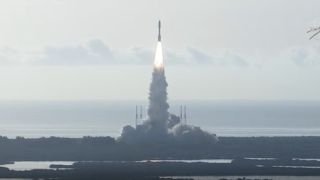
What to Know
- NASA's new rover Perseverance lifted off Thursday morning from the Florida coast on a 300 million miles journey to Mars.
- The rover and its research tools are expected to arrive on Mars in February 2021.
- Perseverance was built at Southern California’s Jet Propulsion Laboratory for a return to Mars after eight successful landings.
A new and better-equipped exploration rover is on its 300 million-mile journey to Mars Thursday morning after lifting off from Cape Canaveral on the Florida coast.
Rover Perseverance is hitching a ride aboard a United Launch Alliance Atlas V 541 rocket that blasted off at about 4:50 a.m. California time.
NASA's science mission chief, Thomas Zurbuchen, pronounced the launch the start of "humanity's first round trip to another planet."
"Oh, I loved it, punching a hole in the sky, right? Getting off the cosmic shore of our Earth, wading out there in the cosmic ocean," he said. "Every time, it gets me."
In addition to addressing the life-on-Mars question, the mission will yield lessons that could pave the way for the arrival of astronauts as early as the 2030s.
"There's a reason we call the robot Perseverance. Because going to Mars is hard," NASA Administrator Jim Bridenstine said just before liftoff. "It is always hard. It's never been easy. In this case, it's harder than ever before because we're doing it in the midst of a pandemic."
Perseverance was built at Southern California’s Jet Propulsion Laboratory for a return to Mars after eight successful landings. This time, the SUV-sized rover is destined for the site of a river delta that might have signs of ancient life on the planet.
After the high-risk Martian entry and landing in an area filled with boulders and rough terrain, Perseverance will unpack its tools. They include cameras, microphones, instruments to study study Martian weather, a drill and miniature helicopter for what will be a history-making flight.
This is the third and final mission to Mars this summer, coming on the heels of launches by the United Arab Emirates and China. Perseverance is scheduled to reach Mars in February 2021 after journeying more than 300 million miles.
Here’s a look at the rover and its mission.
Perseverance vs. Curiosity
The six-wheeled, car-sized Perseverance is a copycat of NASA's Curiosity rover, prowling Mars since 2012, but with more upgrades and bulk. Its 7-foot (2-meter) robotic arm has a stronger grip and bigger drill for collecting rock samples, and it's packed with 23 cameras, most of them in color, plus two more on Ingenuity, the hitchhiking helicopter. The cameras will provide the first glimpse of a parachute billowing open at Mars, with two microphones letting Earthlings eavesdrop for the first time. Once home to a river delta and lake, Jezero Crater is NASA's riskiest Martian landing site yet because of boulders and cliffs, hopefully avoided by the spacecraft's self-navigating systems. Perseverance has more self-driving capability, too, so it can cover more ground than Curiosity. The enhancements make for a higher mission price tag: nearly $3 billion.
Sample Collection
Perseverance will drill into rocks most likely to hold signs of ancient life and stash the collection on the ground to await a future rover. Forty-three sample tubes are on board this rover, each one meticulously scrubbed and baked to remove Earthly microbes. NASA wants to avoid introducing organic molecules from Earth to the returning Martian samples. Each tube can hold one-half ounce (15 grams) of core samples, and the goal is to gather about a pound (0.5 kilogram) altogether for return to Earth. NASA hopes to launch the pickup mission in 2026 and get the samples back on Earth by 2031 -- at the soonest.
Helicopter Demo
The 4-pound (1.8-kilogram) helicopter, Ingenuity, will travel to Mars clutching the rover's belly and, a few months after touchdown, attempt to fly solo. Once dropping onto the Martian surface, Ingenuity will start out like a baby bird, rising 10 feet (3 meters) into the planet's extremely thin atmosphere and flying forward up to 6 feet (2 meters). With each attempt, it will try to go a little higher and farther. "It really is like the Wright brothers' moment," said project manager MiMi Aung. She has one month to squeeze in as many helicopter hops as possible before the rover moves on to more pressing geologic work. The future could see next-generation helicopters scouting out distant Martian territory for astronauts or even robots.
What’s in It for Humans?
Besides the helicopter, Perseverance carries other experiments that could directly benefit astronauts at Mars. An instrument the size of a car battery will covert atmospheric carbon dioxide into oxygen, an essential ingredient for rocket propellant and breathing systems. Another instrument, zapping rocks with lasers to identify organic molecules and minerals, carries samples of spacesuit material. NASA wants to see how the fabrics withstand the harsh Martian environment. It will be the 2030s at best, according to NASA, before astronauts venture to Mars.
Stowaways
A couple Martian meteorites are finally headed home, or at least slivers of them to be used as calibration targets by laser-shooting instruments aboard Perseverance. Other cool stowaways: silicon chips bearing the names of nearly 11 million people who signed up, as well as a small plate showing Earth and Mars on opposite sides of the sun with the message "explore as one" in Morse code tucked into the solar rays. There's also a plaque paying tribute to medical workers on the pandemic's front lines. The coronavirus is preventing hundreds of scientists and other team members from traveling to Cape Canaveral for the launch.

